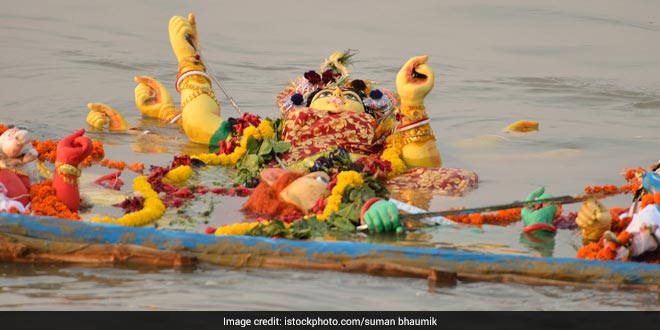New Delhi: Rampant use of prohibited synthetic materials and toxic paints in idols led to many fold increase of heavy metal concentration in the Yamuna following idol immersion, a monitoring committee overseeing the cleaning of the river said. After being apprised by the Central Pollution Control Board (CPCB) that idol immersion following Ganesh Chaturthi and Durga Pooja, and religious activities during Chhat Pooja cause extensive damage to the river, the panel said it “unacceptable and dangerous”.
Also Read: In Pictures: Yamuna River Shows Signs Of Extreme Pollution With Toxic Froth
The monitoring committee has said the Yamuna is “fighting to stay alive” and it would not be possible to rejuvenate the river unless the minimum environmental flow is provided as it is “virtually reduced to a trickle and remains dry in some stretches for almost nine months of the year”. The panel has proposed legal action and imposition of a heavy fine against those violating the norms that led to pollution in the river.
The monitoring committee, formed by the National Green Tribunal (NGT), noted that the concentration of heavy metals increased in the river due to the immersion of painted and polished idols with metallic ornaments and shiny materials.
Post-immersion, the level of chromium increased 11 times from the limit (0.05mg/l) set by the Bureau of Indian Standards (BIS), while iron concentration increased 71 times from the 0.3 mg/l limit. Nickel increased one fold from the 0.02 mg/l BIS limit and lead increased two times from the 0.01 mg/l limit, the CPCB said.
The quality of the river water after idol immersion following Ganesh Chaturthi showed “unacceptable rise of levels of pollutants”, the monitoring committee said, adding,
There is an urgent need to build awareness about how dangerous this can be and to show no latitude when CPCB guidelines are being defied.
According to researchers, the toxicity of heavy metals can damage the functioning of brain, lungs, kidney, liver and other vital organs and also can alter blood composition. Long-term exposure can lead to ailments such as multiple sclerosis, Parkinson’s disease, Alzheimer’s disease and muscular dystrophy, among others.
Also Read: 2% Yamuna Stretch Accounts For 76% Of Pollution In River: Report
CPCB guidelines state that idols should be made from natural materials and clay should be used while backed clay, plaster of paris and other such items should not be allowed. The guidelines said, “If idols are to be painted, water-soluble non-toxic natural dyes should be used. Use of toxic and non-biodegradable chemical dyes for painting idols should be strictly prohibited.”
NGT Chairperson Justice A K Goel had in July formed the monitoring committee comprising retired expert member B S Sajwan and former Delhi chief secretary Shailaja Chandra, and directed them to the submit an action plan and detailed report on cleaning of the river by December 31.
The committee has directed the divisional commissioner, NCT Delhi authorities and other public authorities like Delhi Municipal Corporation (DMC), Delhi Development Authority (DDA), CPCB and Delhi Pollution Control Committee (DPCC) to ensure that a system is established for giving registration, getting undertaking to abide by the CPCB guidelines before granting approval to pooja pandals.
The monitoring committee recommended,
“If the use of prohibited material is noted on random inspection, the pandals, societies who have given an undertaking would need to be fined heavily besides taking other legal action for causing a nuisance.
It also emphasised on raising public awareness about the issue and make people understand why it is important to desist from using paints, plaster of paris, while at the same time ensure that synthetic material is not thrown in the river. The committee had earlier said a small stretch of less than two per cent of the Yamuna accounts for 76 per cent of the river’s pollution.
In the action plan, a copy of which has been accessed by PTI, it is mentioned, “Although the Yamuna river flows only for 54 kilometres from Palla to Badarpur through Delhi, the 22-kilometre stretch from Wazirabad to Okhla, which is less than 2 per cent of the river length of 1,370 kilometres from Yamunotri to Allahabad, accounts for about 76 per cent of the pollution in the river”.
The Yamuna, which is the lifeline of Delhi, is one of the most polluted rivers in the country. About 85 per cent of the pollution is caused by domestic and industrial waste. The quality of the river is severely affected by the discharge of untreated domestic and industrial effluents.
NDTV – Dettol Banega Swachh India campaign lends support to the Government of India’s Swachh Bharat Mission (SBM). Helmed by Campaign Ambassador Amitabh Bachchan, the campaign aims to spread awareness about hygiene and sanitation, the importance of building toilets and making India open defecation free (ODF) by October 2019, a target set by Prime Minister Narendra Modi, when he launched Swachh Bharat Abhiyan in 2014. Over the years, the campaign has widened its scope to cover issues like air pollution, waste management, plastic ban, manual scavenging and menstrual hygiene. The campaign has also focused extensively on marine pollution, clean Ganga Project and rejuvenation of Yamuna, two of India’s major river bodies.

























